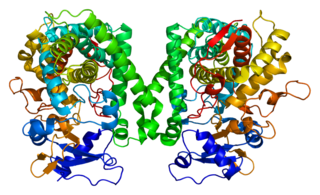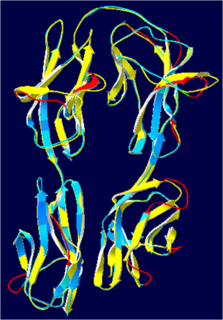Related Research Articles

Cytochromes P450 (CYPs) are a superfamily of enzymes containing heme as a cofactor that functions as monooxygenases. In mammals, these proteins oxidize steroids, fatty acids, and xenobiotics, and are important for the clearance of various compounds, as well as for hormone synthesis and breakdown. In 1963, Estabrook, Cooper, and Rosenthal described the role of CYP as a catalyst in steroid hormone synthesis and drug metabolism. In plants, these proteins are important for the biosynthesis of defensive compounds, fatty acids, and hormones.

Cytochrome P450 2A6 is a member of the cytochrome P450 mixed-function oxidase system, which is involved in the metabolism of xenobiotics in the body. CYP2A6 is the primary enzyme responsible for the oxidation of nicotine and cotinine. It is also involved in the metabolism of several pharmaceuticals, carcinogens, and a number of coumarin-type alkaloids. CYP2A6 is the only enzyme in the human body that appreciably catalyzes the 7-hydroxylation of coumarin, such that the formation of the product of this reaction, 7-hydroxycoumarin, is used as a probe for CYP2A6 activity.

Deltamethrin is a pyrethroid ester insecticide. Deltamethrin plays a key role in controlling malaria vectors, and is used in the manufacture of long-lasting insecticidal mosquito nets; however, resistance of mosquitos and bed bugs to deltamethrin has seen a widespread increase.

Cytochrome P4502C8 (abbreviated CYP2C8), a member of the cytochrome P450 mixed-function oxidase system, is involved in the metabolism of xenobiotics in the body. Cytochrome P4502C8 also possesses epoxygenase activity, i.e. it metabolizes long-chain polyunsaturated fatty acids, e.g. arachidonic acid, eicosapentaenoic acid, docosahexaenoic acid, and Linoleic acid to their biologically active epoxides.

Steroid 21-hydroxylase is an enzyme that hydroxylates steroids at the C21 position and is involved in biosynthesis of aldosterone and cortisol. The enzyme converts progesterone and 17α-hydroxyprogesterone into 11-deoxycorticosterone and 11-deoxycortisol, respectively, within metabolic pathways that ultimately lead to aldosterone and cortisol. Deficiency in the enzyme may cause congenital adrenal hyperplasia.

In enzymology, a sterol 14-demethylase (EC 1.14.13.70) is an enzyme of the Cytochrome P450 (CYP) superfamily. It is any member of the CYP51 family. It catalyzes a chemical reaction such as:

Cytochrome P450 3A5 is a protein that in humans is encoded by the CYP3A5 gene.

Cytochrome P450 2C18 is a protein that in humans is encoded by the CYP2C18 gene.

The halloween genes are a set of genes identified in Drosophila melanogaster that influence embryonic development. All of the genes code for cytochrome P450 enzymes in the ecdysteroidogenic pathway (biosynthesis of ecdysone from cholesterol). Ecdysteroids such as 20-hydroxyecdysone and ecdysone influence many of the morphological, physiological, biochemical changes that occur during molting in insects.

Janet Hemingway is a British infectious diseases specialist. She is the former Director of Liverpool School of Tropical Medicine (LSTM) and founding Director of Infection Innovation Consortium and Professor of Tropical Medicine at LSTM. She is current President of the Royal Society of Tropical Medicine and Hygiene.

Hemolin is an immunoglobulin-like protein exclusively found in Lepidoptera. It was first discovered in immune-challenged pupae of Hyalophora cecropia and Manduca sexta.
CYP303A1 is an insect gene belongs to the cytochrome P450 family, first found in Drosophila melanogaster, highly expressed in pupal stage. Its ortholog also found in Locusta migratoria.
Cytochrome P450, family 105, also known as CYP105, is a cytochrome P450 monooxygenase family in bacteria, predominantly found in the phylum Actinomycetota and the order Actinomycetales. The first three genes and subfamilys identified in this family is the herbicide-inducible P-450SU1 and P-450SU2 from Streptomyces griseolus and choP from Streptomyces sp's cholesterol oxidase promoter region.
Cytochrome P450, family 107, also known as CYP107, is a cytochrome P450 monooxygenase family in bacteria, found to be conserved and highly populated in Streptomyces and Bacillus species. The first gene identified in this family is Cytochrome P450 eryF (CYP107A1) from Saccharopolyspora erythraea. Many enzymes of this family are involved in the synthesis of macrolide antibiotics. The members of this family are widely distributed in Alphaproteobacteria, cyanobacterial, Mycobacterium, Bacillota, and Streptomyces species, which may be due to horizontal gene transfer driven by selection pressure.
Cytochrome P450, family 11, also known as CYP11, is a chordate cytochrome P450 monooxygenase family. This family contains many enzymes involved in steroidogenesis, such as Cholesterol side-chain cleavage enzyme (CYP11A1), Steroid 11β-hydroxylase (CYP11B1) and Aldosterone synthase (CYP11B2). CYP11 can be divided into A to E five subfamilies, and CYP11A are the ohonologues to CYP11C, which duplicated during 2R event, and the tetrapod's CYP11B evolved from CYP11C of its fish ancestors, CYP11D and F found in amphioxus. These are not the typical CYP subfamilies, which share at least 40% amino acid identity, members between CYP11A and B subfamily are only 37.5-38.8% identical, and the CYP11D and E genes seen in modern lancelet is 39% identical to catfish CYP11A1.
Cytochrome P450, family 18, also known as CYP18, is an animal cytochrome P450 family found in insect genomes. It is involved in insecticide resistance. The first member gene identified was CYP18A1, from a Drosophila melanogaster fly, acting as a dimethylnitrosamine demethylase.
Cytochrome P450, family 6, also known as CYP6, is a cytochrome P450 family found in Insect genome. CYP6 and CYP9, another insect CYP family, belong to the same clan as mammalian CYP3 and CYP5 families.
Cytochrome P450, family 12, also known as CYP12, is a cytochrome P450 family found in insect genome belongs to Mitochondrial clan CYPs, which is located in the inner membrane of mitochondria(IMM). The first gene identified in this family is the CYP12A1 from the Musca domestica, which is involved in insecticide resistance. CYP12A1 protein localization in mitochondria by immunohistochemistry and absolute dependence on mitochondrial electron donors adrenodoxin reductase and adrenodoxin.
CYP6M2 is a gene location in Anopheles gambiae chromosome 3R, involved in the insecticide resistant. The enzyme encoded by this gene is capable of directly metabolizing pyrethroids, belongs to the cytochrome P450 family CYP6
Cytochrome P450, family 123, also known as CYP123, is a cytochrome P450 monooxygenase family in bacteria. The first gene in this family to identify function is CYP123A9 from Rhodococcus sp, which catalysis estrone to 16-hydroxyestrone in the estradiol degradation pathway of bacteria.
References
- ↑ Stevens, JL; Snyder, MJ; Koener, JF; Feyereisen, R (July 2000). "Inducible P450s of the CYP9 family from larval Manduca sexta midgut". Insect Biochemistry and Molecular Biology. 30 (7): 559–68. doi:10.1016/s0965-1748(00)00024-2. PMID 10844248.
- ↑ Ishak, IH; Kamgang, B; Ibrahim, SS; Riveron, JM; Irving, H; Wondji, CS (January 2017). "Pyrethroid Resistance in Malaysian Populations of Dengue Vector Aedes aegypti Is Mediated by CYP9 Family of Cytochrome P450 Genes". PLOS Neglected Tropical Diseases. 11 (1): e0005302. doi:10.1371/journal.pntd.0005302. PMC 5289618 . PMID 28114328.
- ↑ Nelson, DR (November 1998). "Metazoan cytochrome P450 evolution". Comparative Biochemistry and Physiology. Part C, Pharmacology, Toxicology & Endocrinology. 121 (1–3): 15–22. doi:10.1016/s0742-8413(98)10027-0. PMID 9972448.
- ↑ Rose, RL; Goh, D; Thompson, DM; Verma, KD; Heckel, DG; Gahan, LJ; Roe, RM; Hodgson, E (June 1997). "Cytochrome P450 (CYP)9A1 in Heliothis virescens: the first member of a new CYP family". Insect Biochemistry and Molecular Biology. 27 (6): 605–15. doi:10.1016/s0965-1748(97)00036-2. PMID 9304798.
- ↑ Shi, Y; Jiang, Q; Yang, Y; Feyereisen, R; Wu, Y (August 2021). "Pyrethroid metabolism by eleven Helicoverpa armigera P450s from the CYP6B and CYP9A subfamilies". Insect Biochemistry and Molecular Biology. 135: 103597. doi:10.1016/j.ibmb.2021.103597. PMID 34089822. S2CID 235353940.